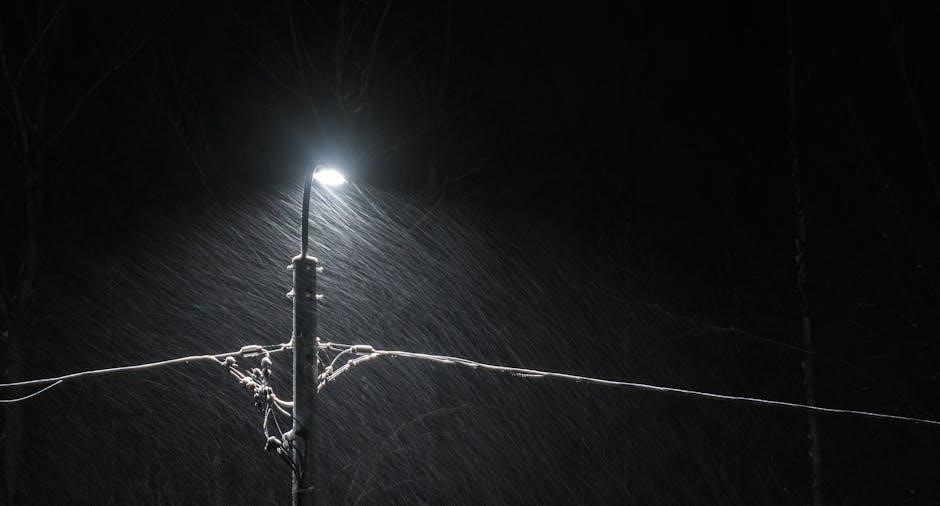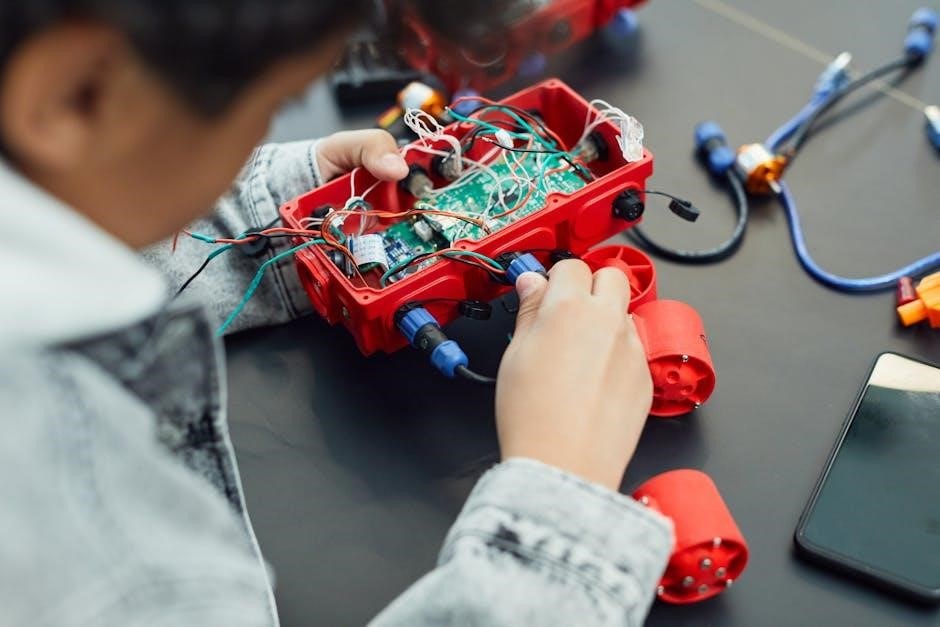Black & Decker Complete Guide to Wiring: An Overview
The Black & Decker Complete Guide to Wiring is a comprehensive manual for homeowners. It offers up-to-date advice and ensures projects meet national electrical codes. Updated editions include new projects and revisions for current electrical standards.
For over a decade, the Black & Decker Complete Guide to Wiring has been a trusted resource for homeowners in North America, offering clear, up-to-date advice on electrical projects. This guide, regularly updated to meet the latest National Electrical Code (NEC) standards, ensures that your wiring projects are safe and compliant. Whether you’re a DIY enthusiast tackling a simple repair or embarking on a more complex wiring project like adding circuits, this guide provides essential knowledge and practical techniques. It covers everything from understanding basic wiring principles to troubleshooting common electrical issues, all presented in an accessible format with detailed diagrams and illustrations. Master home wiring with this guide.

Understanding Electrical Codes and Safety

Navigating electrical codes and safety is paramount for any wiring project. Compliance with the National Electrical Code (NEC) and adherence to safety precautions are crucial for preventing hazards.
Importance of National Electrical Code (NEC) Compliance
Adhering to the National Electrical Code (NEC) standards is not just a suggestion, but a necessity for ensuring electrical safety and preventing hazards in any wiring project. The NEC provides a comprehensive set of guidelines designed to minimize risks such as electrical shocks, fires, and equipment damage. Compliance ensures that all electrical installations meet a minimum safety standard, protecting both people and property.
Following NEC guidelines also ensures that your work is up to code for inspections and insurance purposes. Non-compliance can result in failed inspections, costly rework, and potential legal liabilities. Moreover, NEC compliance promotes consistency and reliability in electrical systems, reducing the likelihood of future problems.
Essential Safety Precautions
Before undertaking any electrical wiring project, prioritizing safety is paramount. Always begin by disconnecting the power supply at the main breaker to avoid electrical shock. Utilize insulated tools designed for electrical work to minimize the risk of contact with live wires. Wear safety glasses to protect your eyes from sparks or debris.
Never work in wet or damp conditions, as water increases the risk of electrocution. Double-check all connections to ensure they are secure and properly grounded. Use a voltage tester to confirm that the power is off before touching any wires. If you’re uncertain about any aspect of the project, consult a qualified electrician to avoid potential hazards and ensure the job is done safely and correctly.

Wiring Basics: Wires, Cables, and Conduit
Understanding wiring basics involves recognizing different types of wires and cables. It includes knowing their specific uses in electrical systems. Also, familiarity with conduit types and their installation is essential.
Types of Wires and Their Uses
Electrical wiring employs various types of wires, each designed for specific purposes. Common wire types include solid and stranded, each offering unique benefits. Solid wire is generally used for permanent installations due to its rigidity; Stranded wire, being more flexible, is better suited for applications requiring movement. Wire insulation is crucial, with types like THHN, THW, and UF catering to different environmental conditions, such as varying temperatures and moisture levels.
The gauge of the wire, indicated by its American Wire Gauge (AWG) number, determines its current-carrying capacity. Lower AWG numbers signify thicker wires capable of handling higher currents. Understanding these wire types and their appropriate uses is fundamental for safe and effective electrical work. Different colors also indicate a wire’s purpose.
Working with Cables
Cables are essential components in residential wiring, typically consisting of multiple insulated wires bundled together within a protective outer jacket. Non-metallic (NM) cable, also known as Romex, is commonly used for interior wiring in dry locations. Underground feeder (UF) cable is designed for direct burial in the ground, making it suitable for outdoor applications like landscape lighting. When working with cables, it’s crucial to handle them carefully to avoid damaging the insulation or conductors.
Properly securing cables to framing members with cable staples is essential to prevent strain and ensure safe installation. Avoid over-tightening staples, as this can damage the cable. Always select the appropriate cable type for the intended application and adhere to local electrical codes. Correct cable management is paramount for safety.
Understanding Conduits
Conduits are protective tubes used to encase electrical wiring, offering physical protection and routing pathways. Rigid metal conduit (RMC) provides robust protection against impact and is often used in exposed locations. Electrical metallic tubing (EMT), also known as thin-wall conduit, is lighter and easier to bend, making it suitable for concealed wiring. Flexible metal conduit (FMC) allows for movement and vibration, ideal for connecting motors. PVC conduit is corrosion-resistant and commonly used underground.
Selecting the right conduit type depends on the environment and application. Proper installation involves using appropriate fittings and connectors to ensure a secure and watertight seal. Conduits must be adequately supported and grounded. Understanding conduit fill capacity is crucial to prevent overheating. Adhering to electrical codes is vital for safety.

Boxes and Panels: The Foundation of Wiring
Electrical boxes and panels are critical components of any wiring system. They provide safe enclosures for connections and protect against electrical hazards. Understanding their types and proper installation is essential for electrical safety;

Types of Electrical Boxes
Electrical boxes are essential components of any wiring system, providing a safe enclosure for electrical connections. Several types of boxes cater to different applications. Plastic boxes, known for their non-conductive properties, are commonly used in residential wiring for switches and receptacles. Metal boxes, like steel or aluminum, offer enhanced durability and protection, often used in areas where physical damage is a concern.
Junction boxes are used to join multiple wires or cables, while outlet boxes house receptacles and switches. Understanding the specific requirements of each type ensures proper selection and installation, enhancing safety and functionality. The right choice depends on the location and purpose of the wiring.
Working with Electrical Panels

Electrical panels, also known as breaker boxes, are the central distribution points for electricity in a home. Working with electrical panels requires caution and a thorough understanding of electrical safety. The panel houses circuit breakers that protect individual circuits from overloads and short circuits. Before working on a panel, always disconnect the main power supply to prevent electrical shock.
Identifying and labeling each circuit breaker is crucial for easy troubleshooting and maintenance. When adding a new circuit, ensure the panel has sufficient capacity and install the appropriate breaker size. Properly connecting wires and grounding the panel are essential for safety and compliance with electrical codes. Regular inspections and maintenance can prevent potential hazards and ensure the panel operates efficiently.

Switches and Receptacles: Installation and Function
Switches control lights and appliances, while receptacles provide power outlets. Proper installation ensures safety and functionality. Understanding wiring configurations and following electrical codes are crucial for successful projects.
Installing Switches
Installing switches involves connecting wires to control electrical circuits, typically for lighting. Begin by turning off the power at the breaker box to ensure safety. Identify the hot, neutral, and ground wires. Connect the hot wire to one of the switch terminals. Attach the wire leading to the light fixture to the other terminal. The neutral wire bypasses the switch and goes directly to the fixture. The ground wire should be connected to the grounding screw on the switch. Secure all connections tightly using wire connectors. Carefully place the switch into the electrical box and screw it in place. Finally, restore power at the breaker and test the switch. Always consult local electrical codes and the Black & Decker guide for detailed instructions.

Installing Receptacles
Installing receptacles, or outlets, requires careful attention to wiring connections. First, always turn off the power at the circuit breaker. Identify the hot, neutral, and ground wires. The hot wire, typically black, connects to the brass-colored screw. The neutral wire, usually white, connects to the silver-colored screw. The ground wire, often bare copper or green, connects to the green grounding screw. Use wire strippers to expose about ¾ inch of wire. Create a hook with the wire and wrap it clockwise around the screw. Tighten the screws securely. Fold the wires neatly into the electrical box. Mount the receptacle into the box and secure it with screws. Restore power at the breaker and test the receptacle with a circuit tester to ensure proper wiring. Consult the Black & Decker guide for detailed diagrams and safety precautions.

Common Wiring Projects and Repairs
This section covers practical wiring projects and essential repairs. Learn to wire sheds or gazebos and troubleshoot common electrical issues effectively. The Black & Decker guide provides detailed instructions for success.
Wiring a Shed or Gazebo
Extending electrical power to a shed or gazebo can significantly enhance its functionality. This project demands careful planning and adherence to electrical codes. Begin by assessing the power needs of the structure, considering lighting, outlets, and any appliances you plan to use. Proper grounding is crucial for safety, so ensure a reliable grounding system. Select the appropriate size and type of wiring for the intended load.
Running the wiring underground requires burying it at the correct depth and using conduit for protection. Inside the shed or gazebo, install electrical boxes and connect wiring to switches and receptacles. Always double-check connections and test the circuit before use. Consulting local codes and obtaining necessary permits is essential before starting any wiring project. Safety should always be the top priority.
Troubleshooting and Repairing Common Wiring Issues
Addressing wiring problems promptly ensures safety and prevents further damage. Common issues include tripped circuit breakers, flickering lights, and non-functional outlets. Before troubleshooting, always disconnect the power supply. Use a non-contact voltage tester to confirm the power is off. Check for loose connections at outlets, switches, and light fixtures. Tighten any loose wires and replace damaged components.
If a circuit breaker repeatedly trips, investigate for overloaded circuits or short circuits. Short circuits often manifest as burned or frayed wires. Replace damaged wiring and ensure proper insulation. For flickering lights, check the bulb and connections, and inspect the switch. When repairing, use wire connectors of the correct size and type. If unsure, consult a qualified electrician.